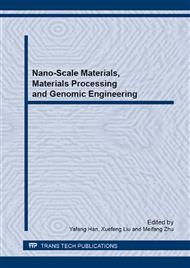p.59
p.64
p.70
p.79
p.84
p.90
p.95
p.100
p.106
Research of Crystallization Kinetics and Thermal Stability of W48.5Ni34Fe14.6B2.9 Amorphous Ribbons
Abstract:
The W48.5Ni34Fe14.6B2.9 (wt.%) amorphous ribbons were prepared using melt spinning method. The crystallization kinetics of amorphous ribbons was investigated by differential scanning calorimeter (DSC) at different heating rates from 10 to 40 K/min. The activation energy of amorphous ribbons was simulated by Kissinger and Ozawa equations, respectively. The precipitated phases at different annealing temperatures were analyzed by X-ray diffraction (XRD). The results showed that the glass transition temperature (Tg), the crystallization temperature (Tx) and the peak temperature (Tp) were found to increase during enhancing heating rate, indicating the obvious kinetic effects of glass transition and crystallization. The consistency of values of the activation energy calculated by Kissinger and Ozawa equations suggested the good accuracy about experiment results. The specific temperatures of Tx and Tp detected by DSC and the deduced crystallization activation energy are generally higher than these of other amorphous alloys, which suggests a higher resistance to crystallization. The W48.5Ni34Fe14.6B2.9 alloy substantially remained at amorphous structure when annealed at 923K for 60 min, showing that the alloy possessed a higher thermal stability.
Info:
Periodical:
Pages:
84-89
Citation:
Online since:
April 2014
Authors:
Price:
Сopyright:
© 2014 Trans Tech Publications Ltd. All Rights Reserved
Share:
Citation:


